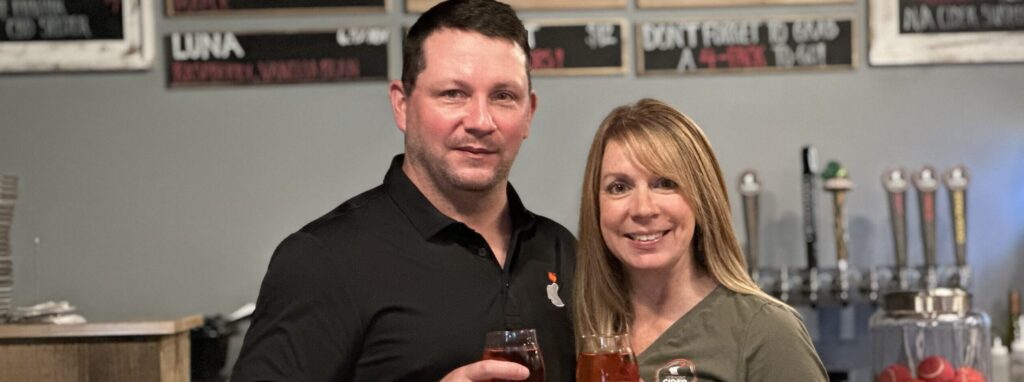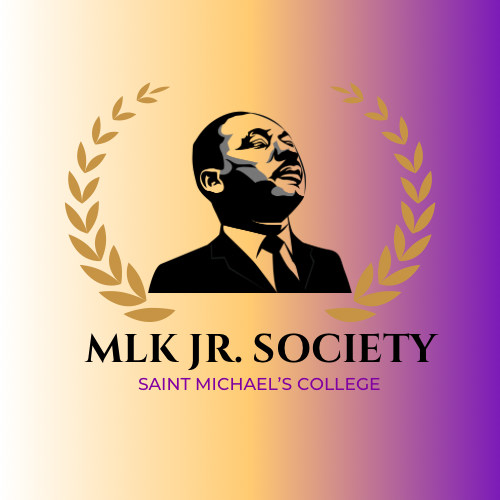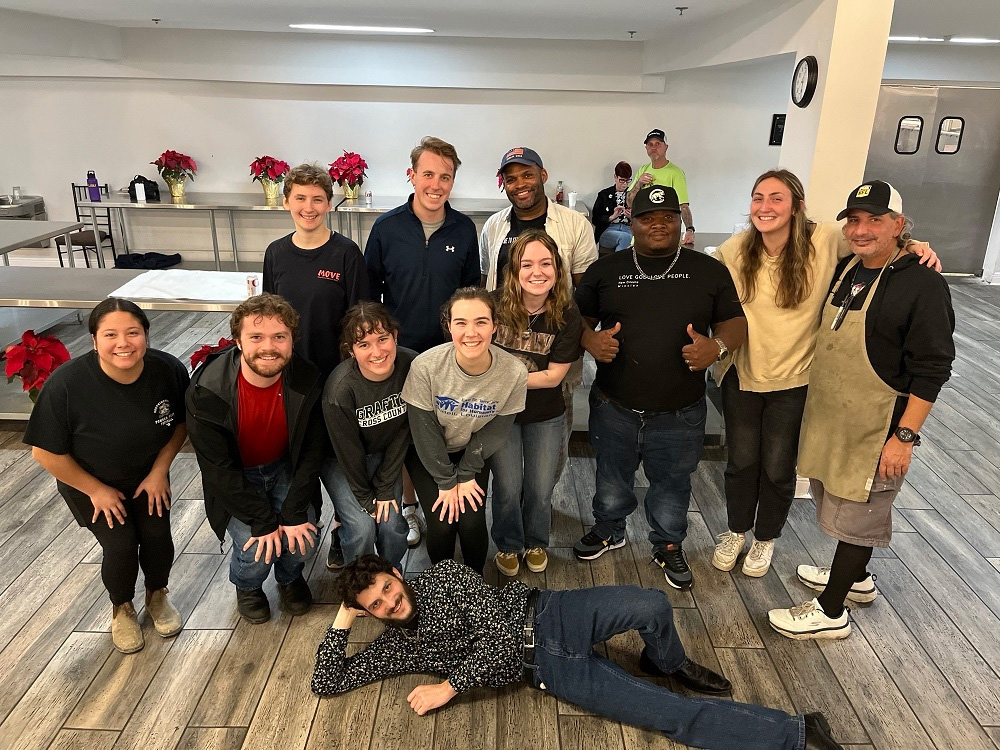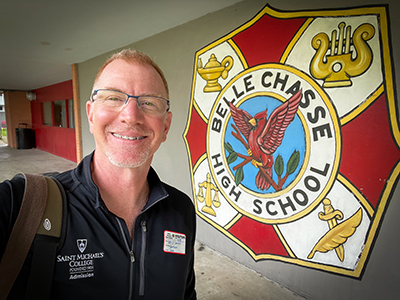Theologian tells story of diversity on religious college campuses
Professor Jeannine Hill Fletcher of Fordham examines what role college communities might play today to best advance inclusion and be accountable for vast inequities of history

Jeannine Hill Fletcher makes a point during her talk Wednesday in the Room. (Photos by Mark Tarnacki)
During a late-afternoon talk Wednesday in the Dion Student Center Roy Room, a Fordham University theologian explored how college campuses in the United States have and have not fostered diversity, with particular attention to religiously affiliated institutions through their history.
Professor Jeannine Hill Fletcher accompanied her presentation, sponsored by the Edmundite Center for Faith and Culture, with vivid PowerPoint slides about history or concepts relevant to her key points. To start, the speaker said, she sought to “recognize historical failures and our contemporary culture of conflict,” in order to probe the question “What role should our campuses be playing today?”
Fr. David Theroux, director of the Center, introduced Hill Fletcher to an audience of about 30, including much of the resident Edmundite community, and students. According to her biography, Hill Fletcher “is a constructive theologian whose research is at the intersection of Christian systematic theology and issues of diversity (including gender, race and religious diversity). She has been at Fordham University – a predominantly white institution in the Jesuit Catholic tradition – for 20 years.”
Her most recent book, The Sin of White Supremacy: Christianity, Racism and Religious Diversity in America (Orbis, 2017), emerged from various anti-racism initiatives on her own campus and her work as the faculty director of the service-learning program. Her training also has included work with the grassroots social justice organization, the Northwest Bronx Community and Clergy Coalition, an inter-generational, multi-racial, multi-religious group organizing to address social justice issues in New York City and beyond.

Fr. David Theroux, S.S.E. ”70, director of the Edmundite Center for Faith and Culture, introduces the speaker. Behind her are Religious Studies Department Chair Ray Patterson and the Center’s former director, Edward Mahoney.
Her current work (tentatively titled, Grace of the Ghosts: A Theology of Institutional Accountability) looks at college campuses as the site of illicitly received benefits (from the sins of white supremacy) and asks how our institutions can be locations for social change, Fr. Theroux said.
Defining the Terms
Hill Fletcher began by clarifying terms central to her work, starting with the word “diversity” itself – it just means difference or variety, she said, but in today’s context means the practice of working together within that variety. She then introduced and spent time with a more complex term – “agonistic” – originally, a science term that gets at a dynamic of balance and struggle among diverse parts of a thing, minus the sense of hostility that “antagonistic” carries. Examples might be life in a family, which can be more cooperative than hostile, yet still truly be a struggle to find proper balance. A slide image of dancers precariously balancing one another to create an intended effect drove home her point.
That idea led her to consider “forms of diversity we’ve come to associate with race” – that is, race as a socially constructed or imagined category that came into use at a particular time and place in order to “sort” people. Thus, an important distinction for her is not thinking of people as “having a race” so much as, their being “racialized” by others. The people doing that sorting then grant or withhold things based on the “race” into which a person is sorted. She said this was her frame for talking about the history of diversity “and how it lands on college campuses.”
A good early interjected student question led to a discussion on how “race” is changeable based on groups variously identified, as, for example, “mulatto” or “Latino/Latina” or of middle eastern origins through different time periods who might or might not check a “white” box on a census form question, depending on era and place. Another question led her to observe that “even when we say we are one human race, we have in the modern West been racialized, and that gets in the way of our being one human race.”
She moved on from there to present “three chapters” explaining how we got to a current moment on campuses that feels conflicted on the topic of race. Those chapters are “Indigenous-European Encounter, Economy of Enslavement, and U.S. Expansion, Immigration and Segregation.”
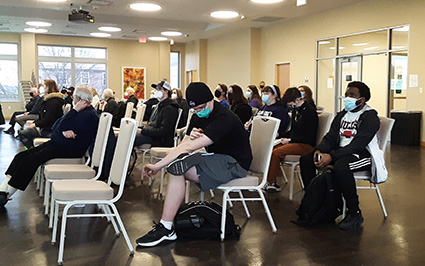
The audience for Wednesday’s lecture included Edmundites, students, faculty and staff.
Under the first category, she spent some time telling about Eleazar Wheelock, a Congregationalist minister who established Dartmouth College, along with Yale’s 7th President, Ezra Stiles, and Georgetown University’s founding minister, the first Catholic bishop in the U.S. John Carroll, and their understandings of native populations and education. A broad conclusion she arrived at was that “indigenous peoples were racialized as ‘other,’ but their diversity was brought into relationship with white Christians only through erasure of culture, language and religion” — even for the few allowed to encounter early higher education in those long-ago days. She touched on Vermont’s own history with the Abenaki, and on Ezra Stiles also co-founding Brown University, which has wrestled in recent years over the wealth of the college linked to deep involvement with the slave trade.
That led her to her “Chapter Two, Economy of Enslavement.” She told how the Northeast had many of the earliest African Americans to attend colleges, such as Vermonter Alexander Twilight at Middlebury in the 1820s. She talked about the Underground Railroad as supporting the struggle for freedom, and said how churches or schools often were sites of sharing information about this aspect of our nation’s struggle. She told the bleak tale of Noyes Academy in New Hampshire, established in 1835 for African American boys and girls, but the townspeople literally pulled the school building out of town with an ox team. She described how John Henry Hopkins, the first Episcopal bishop of Vermont, used specious Bible based arguments to support slavery, showing how even in the north, racism remained entrenched.
The most famous mobilizers of abolition were not from college campus, she said. Nat Turner, Sojourner Truth and Frederick Douglass made the most eloquent arguments against racism but from other pulpits, and their points found their way to conversations on campuses, records show, according to the speaker, who also mentioned early Asians and African-American women pioneers in higher education farther down the road.
Eventually, the great African-American author and activist W.E.B. Dubois sent a survey in the early 1900s to U.S. college leaders to find more about how diversity was growing on college campuses, and most of the responses from colleges revealed little or no acceptance of African-American students, nor much inclination to ever seek them, sadly, she said. “Even though we have diversity in the citizens of the U.S., we do not have diversity on the college campuses” in this period, she said – an era that saw development of Historically Black Universities and Colleges (HBUCs) partly as a result. It is the same era that Saint Michael’s was founded, she said, noting the College’s long legacy later in the century with the Southern Missions serving Black populations that is a credit to the institution in advancing social progress on racial equity, even though the College itself has not had a large number of racially diverse students through its history (even if sons of Catholic immigrants were diverse in their national origins).
She told of the enormous impacts of the era of lynching culture and the Great Depression on Black educational opportunity. The first was a case of direct intimidating violence keeping African Americans from accessing education and its advantages at every level of society; while, in the Depression era, New Deal legislation meant the new FHA let whites own houses on a wide scale for the first time. However, Blacks and minorities could not get loans for all-important home ownership, limiting their ability through generations (up to this very day) to pay for higher education. She showed a slide with language from a manual widely used in U.S. real estate from 1931 until at least 1962, from a then-respected University of Chicago economist that played a significant role in directing wealth only into some hands. The manual offered lists that “rated” racialized groups, based on allegedly which ones were more likely to pay back a loan by ethnic heritage. Its effect was to keep minorities from getting any loans or owning homes, which is at the heart of upward mobility and opportunity for families.
Hill Fletcher in her talk eventually drew a line from the organizing and activism of the 1960s and 1970s to the activism of today when college campuses remain a place where the “agonistic” struggle for a more just expression of diversity still can be found. College students were among those eventually identifying social inequities — including on racial lines — and making a cause from them with such initiatives as freedom rides and lunch counter sit-ins, showing how campuses can be can places to produce “alternative knowledge” that is important for people to know.
She thus turned in conclusion to diversity on campuses today, saying how we have diversity in the nation today, but also what she calls a preponderance of “Predominantly White Institutions.” She urged college leaders today to ask a series of important questions, such as: “What is the culture of the campus and what is the culture of the classroom?; Who holds power to make decisions?; how do we share power?; and “What does the content communicate about what is valued knowledge?” The speaker said colleges in her view ought to “invest in the skill set of navigating difference,” enacting strategies that “put a pause and interrupt biased behavior.”
Time for Questions
During questions, she asked students what they have learned in their high school days about diversity and race, and some said they covered such topics as systemic racism, “red-lining” neighborhoods or recognizing indigenous cultures, if briefly, but with that new awareness, they researched more on their own.
Hill Fletcher told how the “racial wealth gap” resulting from the forces she had just described creates a ratio of close to 20 to 1 of white wealth compared with Black wealth. The speaker said only in her adult life has she come to recognize we have a system of racism in the U.S. “We can’t get rid of racism until we get rid of white supremacy” she said, adding, “I think now we have to work … to ground people in deep heritage and envision transforming a racial wealth gap.”
“When we’re thinking about civil rights, we’re not just thinking of MLK,” she said, adding that a prevalent false myth that many students receive is that “things were bad, then we got MLK and look how good they got.”
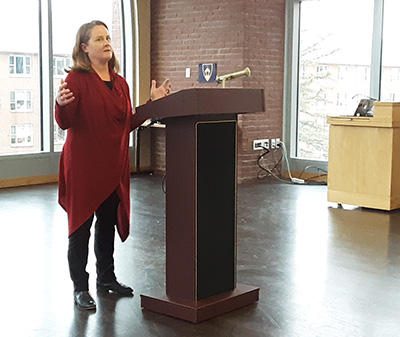
The speaker also took questions from the audience during her presentation.
“As a white theologian, I must say this cannot land on my colleagues of color, I need to be in relation with them so they know we are partnering — this can’t be their job,” she said. “We can keep studying what we love but with an anti-racist lens.”
“Each of these topics – campus culture, campus curriculum and campus conversations — reminds us that the work of fostering diversity on our college campus is the work of everyone, across the disciplines,” she said. Hill Fletcher quoted her favorite college chaplain, Imam Halid Latif at NYU, who once stated in a tweet she found memorable that “organized evil will always triumph over disorganized righteousness.”
That means “we must be organized,” she said, in advancing campus diversity, or at school board meetings in our wider communities, as recent news shows so dramatically. When it comes to such widely contested cultural and social issues, “college campuses have a role to play, and we need to play it, because in this agonistic moment, organized white interests will triumph over disorganized diversity every time.”
